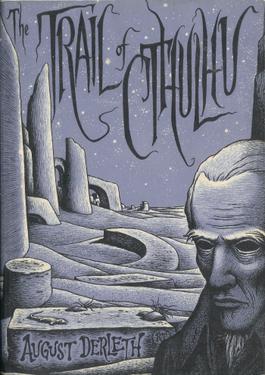
Dr. Fu Manchu is a supervillain who was introduced in a series of novels by the English author Sax Rohmer beginning shortly before World War I and continuing for another forty years. The character featured in cinema, television, radio, comic strips and comic books for over 100 years, and he has also become an archetype of the evil criminal genius and mad scientist, while lending his name to the Fu Manchu moustache.

Horror is a genre of speculative fiction that is intended to disturb, frighten, or scare. Horror is often divided into the sub-genres of psychological horror and supernatural horror, which are in the realm of speculative fiction. Literary historian J. A. Cuddon, in 1984, defined the horror story as "a piece of fiction in prose of variable length ... which shocks, or even frightens the reader, or perhaps induces a feeling of repulsion or loathing". Horror intends to create an eerie and frightening atmosphere for the reader. Often the central menace of a work of horror fiction can be interpreted as a metaphor for larger fears of a society.

Robert Albert Bloch was an American fiction writer, primarily of crime, psychological horror and fantasy, much of which has been dramatized for radio, cinema and television. He also wrote a relatively small amount of science fiction. His writing career lasted 60 years, including more than 30 years in television and film. He began his professional writing career immediately after graduation from high school, aged 17. Best known as the writer of Psycho (1959), the basis for the film of the same name by Alfred Hitchcock, Bloch wrote hundreds of short stories and over 30 novels. He was a protégé of H. P. Lovecraft, who was the first to seriously encourage his talent. However, while he started emulating Lovecraft and his brand of cosmic horror, he later specialized in crime and horror stories working with a more psychological approach.

Arthur Henry "Sarsfield" Ward, better known as Sax Rohmer, was an English novelist. He is best remembered for his series of novels featuring the master criminal Fu Manchu.
Arkham House was an American publishing house specializing in weird fiction. It was founded in Sauk City, Wisconsin, in 1939 by August Derleth and Donald Wandrei to publish hardcover collections of H. P. Lovecraft's best works, which had previously been published only in pulp magazines. The company's name is derived from Lovecraft's fictional New England city, Arkham, Massachusetts. Arkham House editions are noted for the quality of their printing and binding. The printer's mark for Arkham House was designed by Frank Utpatel.
Book of Thoth is a name given to many ancient Egyptian texts supposed to have been written by Thoth, the Egyptian god of writing and knowledge. They include many texts that were claimed to exist by ancient authors and a magical book that appears in an Egyptian work of fiction.

The Case of Charles Dexter Ward is a short horror novel by American writer H. P. Lovecraft, written in early 1927, but not published during the author's lifetime. Set in Lovecraft's hometown of Providence, Rhode Island, it was first published in the May and July issues of Weird Tales in 1941; the first complete publication was in Arkham House's Beyond the Wall of Sleep collection (1943). It is included in the Library of America volume of Lovecraft's work.

Frank Belknap Long Jr. was an American writer of horror fiction, fantasy, science fiction, poetry, gothic romance, comic books, and non-fiction. Though his writing career spanned seven decades, he is best known for his horror and science fiction short stories, including contributions to the Cthulhu Mythos alongside his friend, H. P. Lovecraft. During his life, Long received the World Fantasy Award for Life Achievement, the Bram Stoker Award for Lifetime Achievement, and the First Fandom Hall of Fame Award (1977).
Dr Terrible's House of Horrible is a satirical British comedy horror anthology series created by Graham Duff, who co-wrote the series with Steve Coogan. BBC Two broadcast the series in 2001. The title parodies Amicus Productions' anthology film Dr Terror's House of Horrors (1965). Coogan presents each episode as Dr. Terrible, and plays various roles throughout.

Vampires are frequently represented in popular culture across various forms of media, including appearances in ballet, films, literature, music, opera, theatre, paintings, and video games.

Occult detective fiction is a subgenre of detective fiction that combines the tropes of the main genre with those of supernatural, fantasy and/or horror fiction. Unlike the traditional detective who investigates murder and other common crimes, the occult detective is employed in cases involving ghosts, demons, curses, magic, vampires, undead, monsters and other supernatural elements. Some occult detectives are portrayed as being psychic or in possession of other paranormal or magical powers.

Leslie Noel Daniels III, better known as Les Daniels, was an American writer.
Gary William Crawford was an American writer and small press publisher.
Jove Books, formerly known as Pyramid Books, is an American paperback and eBook publishing imprint, founded as an independent paperback house in 1949 by Almat Magazine Publishers. The company was sold to the Walter Reade Organization in the late 1960s. It was acquired in 1974 by Harcourt Brace which renamed it to Jove in 1977 and continued the line as an imprint. In 1979, they sold it to The Putnam Berkley Group, which is now part of the Penguin Group.

The Trail of Cthulhu is a series of interconnected short stories by American writer August Derleth as part of the Cthulhu Mythos genre of horror fiction. The stories chronicle the struggles of Laban Shrewsbury and his companions against the Great Old Ones, particularly Cthulhu.

This Magazine is Haunted is a horror comic that was originally published by Fawcett between 1951 and 1953. Running 14 issues, it was the first of Fawcett's supernatural line; a string of titles which included Beware! Terror Tales, Worlds of Fear, Strange Suspense Stories, and Unknown Worlds.
Sumuru is a female supervillain created by Sax Rohmer, author of the Fu Manchu series of novels. She first appeared in a 1945-1946 BBC radio serial, which was rewritten as a novel in 1950. Four more novels were published between 1951 and 1956. Two movies were then made in the 1960s and one more in 2003.

Witch Doctor is a US comic book created by writer Brandon Seifert and artist Lukas Ketner. It was the first title published by Skybound Entertainment, an imprint of Image Comics. As of early 2014, Witch Doctor consists of a four-issue mini-series, an issue #0 printed as a flipbook with The Walking Dead #85, a one-shot subtitled Witch Doctor: The Resuscitation, and a second six-issue mini-series entitled Witch Doctor: Mal Practice, which debuted in November 2012. The first mini-series and #0 issue were reprinted in a collected edition called Witch Doctor Vol. 1: Under the Knife, while the second mini-series and The Resuscitation are scheduled to be collected as Witch Doctor Vol. 2: Mal Practice in June 2013.
Zheng Bao Yu, is a supervillain appearing in American comic books published by Marvel Comics. She is the daughter of Zheng Zu and the older half-sister of Shang-Chi.












